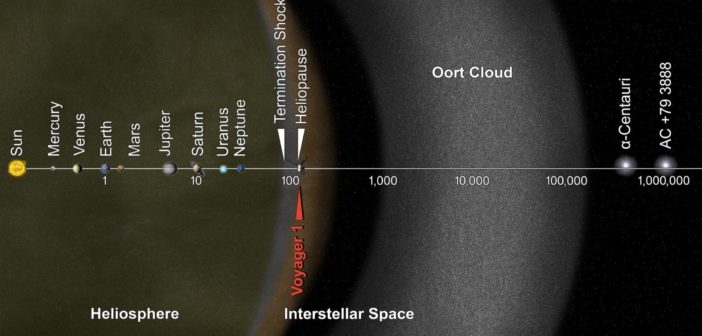In 2012, Voyager 1 zipped across the heliopause. Five and a half years later, Voyager 2 still hasn’t followed its twin into interstellar space. Can models of the heliopause location help determine why?
How Far to the Heliopause?

Artist’s conception of the heliosphere with the important structures and boundaries labeled. [NASA/Goddard/Walt Feimer]
NASA’s twin Voyager spacecraft were poised to cross the heliopause after completing their tour of the outer planets in the 1980s. In 2012, Voyager 1 registered a sharp increase in the density of interstellar particles, indicating that the spacecraft had passed out of the heliosphere and into the interstellar medium. The slower-moving Voyager 2 was set to pierce the heliopause along a different trajectory, but so far no measurements have shown that the spacecraft has bid farewell to our solar system.
In a recent study, a team of scientists led by Haruichi Washimi (Kyushu University, Japan and CSPAR, University of Alabama-Huntsville) argues that models of the heliosphere can help explain this behavior. Because the heliopause location is controlled by factors that vary on many spatial and temporal scales, Washimi and collaborators turn to three-dimensional, time-dependent magnetohydrodynamics simulations of the heliosphere. In particular, they investigate how the position of the heliopause along the trajectories of Voyager 1 and Voyager 2 changes over time.

Modeled location of the heliopause along the paths of Voyagers 1 (blue) and 2 (orange). Click for a closer look. The red star indicates the location at which Voyager 1 crossed the heliopause. The current location of Voyager 2 is marked with a red circle. [Washimi et al. 2017]
A Time-Varying Barrier
The authors consider the impact that solar flares, coronal mass ejections, and other disturbances in the solar outflow have on the heliopause distance. These solar disturbances intermingle as they travel outward to form what the authors call global merged interaction regions.
Using their hydrodynamical simulations, Washimi and collaborators capture the complex behavior of the global merged interaction regions as they propagate through the termination shock and collide with the heliopause. Part of the shock is transmitted into the local interstellar medium, while part of it is reflected back toward and collides with the termination shock, which is pushed toward the Sun. This complex interplay of transmitted and reflected shocks — combined with the nonuniformity of the local interstellar medium — causes the heliopause location to vary dramatically in time as well as space.
What Does this Mean for Voyager 2?
Washimi and collaborators find that the location of the heliopause along the trajectories of Voyagers 1 and 2 has changed considerably over the past decade. In particular, they find that the heliopause has been pushed outward over the past few years due to an increase in the solar wind ram pressure. According to their simulations, Voyager 2 is currently traveling outward faster than the heliopause is advancing, which means that the spacecraft should soon cross the boundary — perhaps even this year — to become Earth’s second interstellar messenger.
Citation
Haruichi Washimi et al 2017 ApJL 846 L9. doi:10.3847/2041-8213/aa8556


1 Comment
Pingback: 1,000 AAS Nova Highlights and Five Years of Astronomy